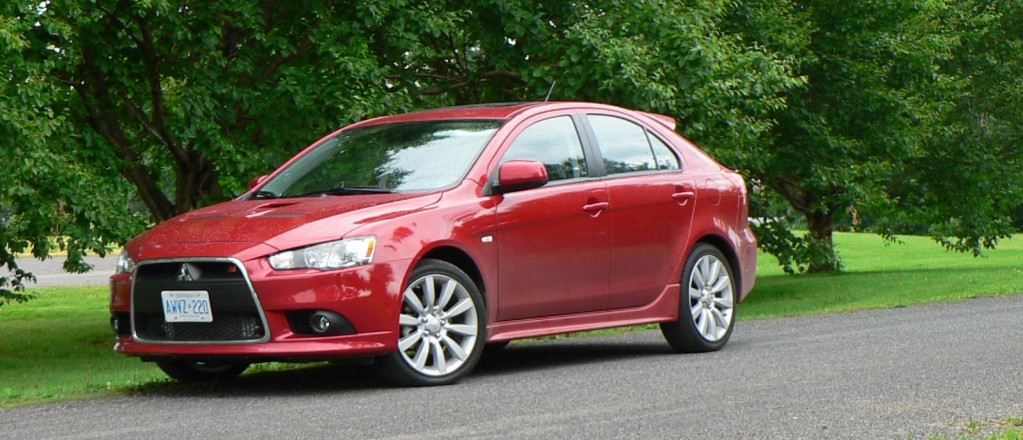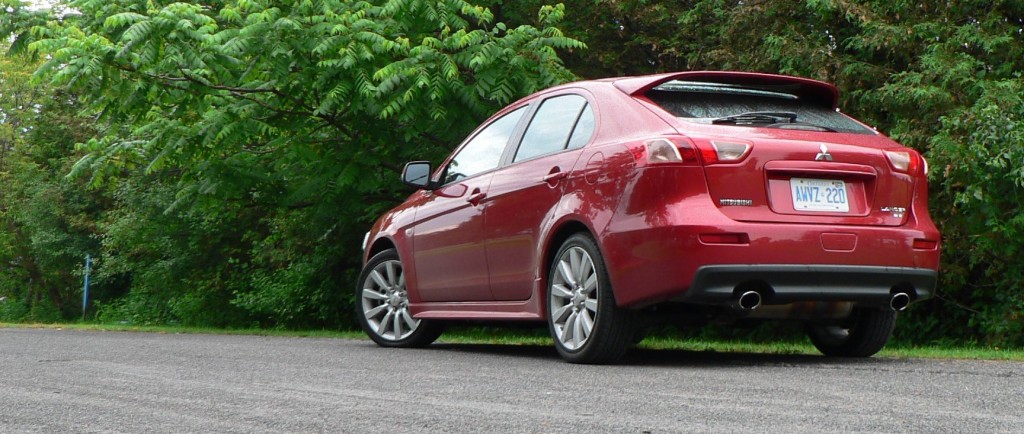Road Test: 2010 Mitsubishi Lancer Sportback Ralliart
[svgallery name=”10_Mitsibishi_Lancer_Sportback”]
Story and photos by John LeBlanc
According to the Chinese calendar, 2008 was the Year of the Rat. For Japanese automaker Mitsubishi however, last year was ostensibly the Year of the Evo—as in the Lancer Evolution.
Born more than 16 years ago in deference to World Rally Championship homologation requirements, Mitsubishi’s high-performance, all-wheel-drive, four-door compact sports sedan was never sold in Canada. As you can imagine, pent up demand was met with critical acclaim from driving enthusiasts with the added bonus of a divisional win at its competitive debut—the weeklong Targa Newfoundland road rally.
But just as archrival Subaru offers a less expensive (and extreme) WRX to its full-blown WRX STi, for 2009 Mitsubishi is debuting tamer all-wheel-drive versions of the Evo in five-passenger, five-door Ralliart sedan and new Sportback Ralliart hatchback iterations.
Philosophically, the 2009 Lancer Sportback Ralliart exists for two reasons: to go toe-to-toe in showrooms with Subaru’s regular-strength WRX hatch; and a more practical hatchback and costly version of the track-ready Evo sedan.
Whereas Lancer Evo pricing ranges between $39,998 to almost $50,000, the next-rung down Ralliarts start at $32,998 for the four-door and $33,498 for our five-door Sportback tester. Mitsu’s six-speed Twin Clutch-Sportronic Shift Transmission—a dual-clutch automatic with normal and sports settings and proper (downshift on the right, up shift on the left) steering wheel mounted paddle shifters—is the only transmission choice on all Ralliarts.
A $5,000 Premium package added goodies to our example, like a navigation system, upgraded audio system and leather/suede Recaro sport seats. Comparably equipped Lancer Sportback Ralliart rivals include the $34,895 Subaru WRX five-door and $36,900 Audi A3 2.0T Quattro.
Canadians tend to love hatchbacks for their family-friendly versatility. And the five-door Lancer Sportback certainly offers more room than its sedan counterpart. Trunk space goes up from 283 to 390 litres. Fold the rear seats down, and room grows to 1,398L. Compared to the WRX, though, the Sportback’s more sweptback rear glass means there’s 148L more trunk space with the seats up in the Subaru.
While the added cargo room and additional rear aperture are the Sportback’s most distinctive qualities, the optional Recaro sports seats certainly add to the Ralliart’s Evo-mimicking interior accommodations. But otherwise, its cockpit is standard Lancer fare—functional, proper driving relationships between the steering wheel, pedals and shifter with easy-to-use driver controls.
In the spirit of full journalistic disclosure, yours truly co-drove a prototype 2009 Lancer Ralliart sedan at last year’s Targa Newfoundland (link here: http://en.autos.sympatico.msn.ca/targa/article.aspx?cp-documentid=10786798). It’s inherent toughness passed down from the rally-bred Evo got us through a week that involved the odd ditch or two. Only, the performance difference, compared to its big brother Evo, was easily exaggerated in such a competitive environment.
The Ralliart’s all-aluminum 2.0-litre four-cylinder engine is similar to the Evo’s, though, except for using a smaller, single-scroll turbo in place of a twin-scroll unit. Accessible power is the premise. Horsepower drops from the Evo’s high-revving 291 hp to 237 hp at 6,000 rpm, while the torque number falls 50 lb-ft to 250 lb-ft; but its available at a more accessible 2,500 to 4,000 rpm.
The Sportback Ralliart may have more juice under its hood than the 224 hp WRX or 200 hp A3. But its 1,620 kg curb weight (almost 200 kg more than the Subaru) literally weighs it down. From a standstill, the run to 100 km/h takes 7.1 seven seconds—about one second slower than the WRX, and 1.5 seconds behind the Evo. Unfortunately, the Ralliart’s avoirdupois hurts fuel economy as well: we saw an as-tested 13.8L/100 km.
Enthusiasts may bemoan the lack of a god ol’ fashioned manual gearbox in the Mitsu. One thing Subaru can’t offer, though, is the Ralliart’s excellent Twin-Clutch Sequential Sportshift Transmission (TC-SST).
Similar to the A3’s S Tronic gearbox, the Mitsu unit is an automated dual-clutch setup. Except for the deletion of launch control, the Ralliart’s tranny is shared with the Evo. Drivers can choose between automatic modes in Drive or Sport (that lets engine revs reach redline and downshifts down more aggressively) or Manual, which lets drivers access the paddle shifters. Overall, TC-SST impresses with its smoothness from rest, near-instantaneous shifts and refinement.
Forget about the power differences between the Ralliart and Evo Lancers for one moment: The biggest difference from behind the wheel is in how these two Mitsus handle the road.
Although the Ralliart get an active centre differential, it really misses the Evo’s active yaw control that distributes torque between the rear wheels. Because of this—and a nose heavy (60 per cent front/40 per cent rear) weight bias—the Ralliart doesn’t like to turn into corners as sharply, with understeer being the end result. Plus, a softer suspension delivers a surprising amount of body roll.
Conversely, the Ralliart delivers an outstanding ride on winter ravaged Canadian roads. And its has confident-inspiring high-speed stability and composure. On backroads, it likes big seeping curves, whereas the Evo attacks tight switchbacks like a lion on an impala. The Ralliart also won’t steer you wrong. It’s well weighted, with a lot more feel than what you’ll find at the helm of a WRX.
If you were hoping the new Lancer Sportback Ralliart would be a bargain-basement Evo—sorry—its just not as razor-sharp in its handling nor in the performance department. In fact, for only a couple of thousands dollars more, you can get into an Evo. Granted, without many of the Sportback Ralliart’s features (TC-SST) or a fifth door.
(And just a reminder: if you like the idea of a five-door Lancer, but don’t want/need the go-faster Ralliart kit, AWD or TC-SST autobox, Mitsubishi Canada will gladly sell you a 168 hp front-wheel-drive Sportback GTS with a five-speed manual for a little as $23,498.)
But for customers looking for a more refined, day-to-day diving experience, with the versatility of the TC-SST transmission and that big rear opening, the 2009 Mitsubishi Lancer Sportback Ralliart offers all that and a hint of the Evo that inspired it in the first place—whatever type of calendar you use.
2009 Mitsubishi Lancer Sportback Ralliart
Base price/as-tested: $33,498/$38,498
Type of vehicle: AWD compact five-door hatchback
Engine: 2.0L, 16-valve DOHC I4
Power/Torque: 237 hp / 253 lb.-ft.
Transmission: Dual-clutch automatic
Fuel consumption L/100 km (city/hwy/as-tested): 12.2 / 8.0 /13.8
Competition: Audi A3 2.0T Quattro, Subaru WRX
ROAD TEST SUMMARY
PROS
Class-leading power and torque
Versatile Twin-Clutch tranny
Five-door practicality
CONS
No available manual transmission
Turbo lag hurts acceleration
Guzzles gas when driven as advertised







![[del.icio.us]](https://www.straight-six.com/wp-content/plugins/bookmarkify/delicious.png)
![[Digg]](https://www.straight-six.com/wp-content/plugins/bookmarkify/digg.png)
![[Facebook]](https://www.straight-six.com/wp-content/plugins/bookmarkify/facebook.png)
![[Google]](https://www.straight-six.com/wp-content/plugins/bookmarkify/google.png)
![[Reddit]](https://www.straight-six.com/wp-content/plugins/bookmarkify/reddit.png)
![[StumbleUpon]](https://www.straight-six.com/wp-content/plugins/bookmarkify/stumbleupon.png)
![[Twitter]](https://www.straight-six.com/wp-content/plugins/bookmarkify/twitter.png)
![[Email]](https://www.straight-six.com/wp-content/plugins/bookmarkify/email.png)